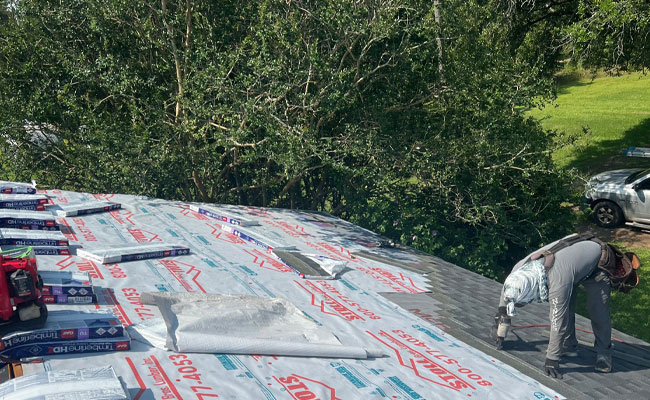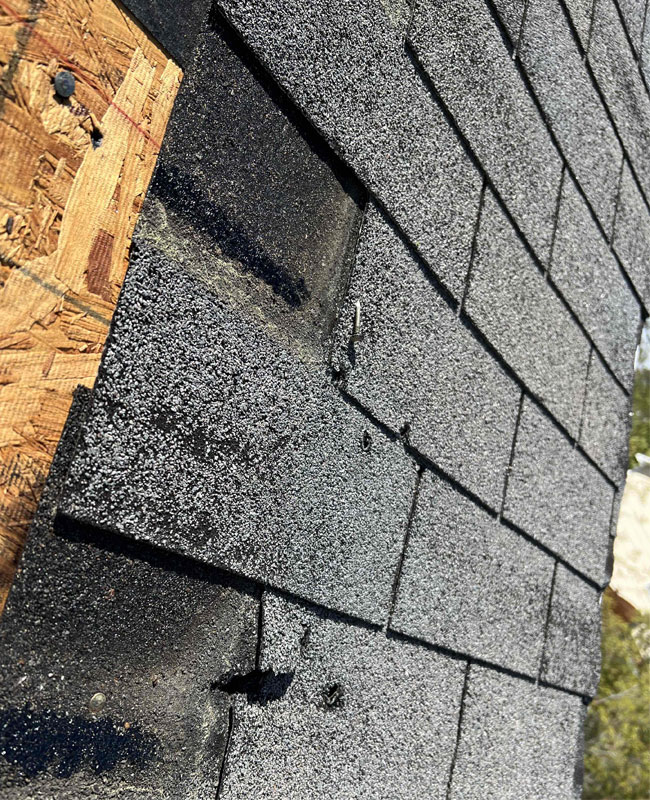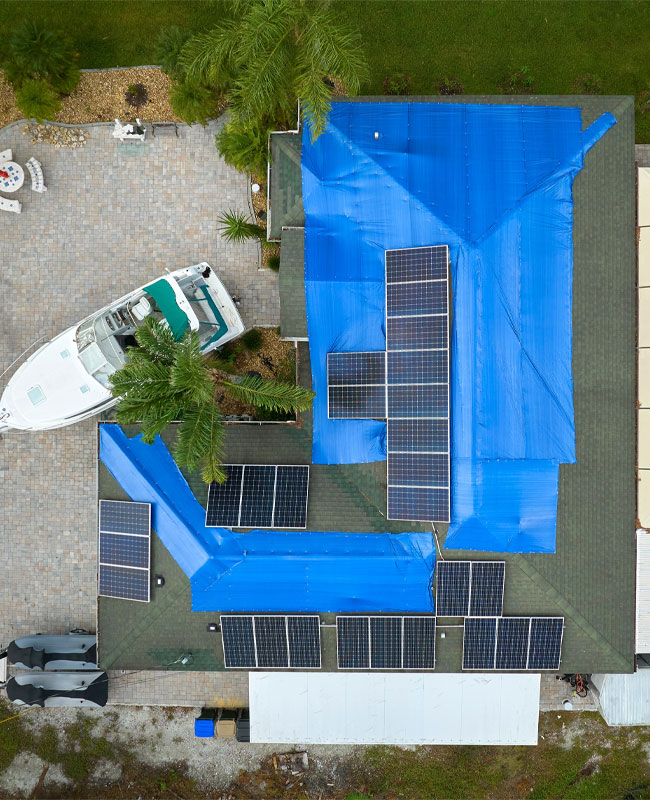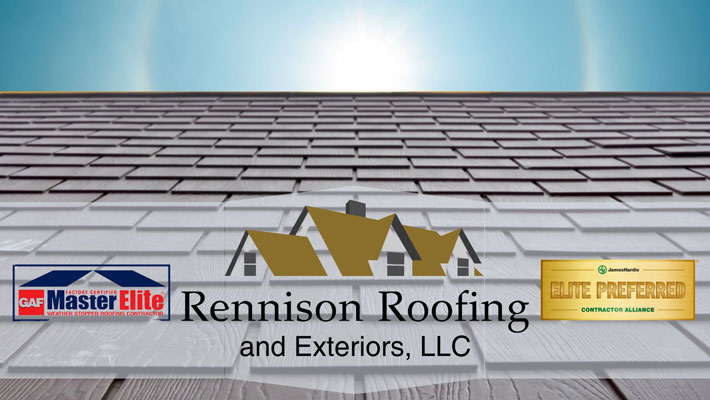What to Do When Your Roof Suffers Storm Damage
If you’re sitting at home right now, wondering what to do now that a major storm has passed and you are worrying about potential damage to your roof, know that you’ve come to the right place! Post-storm recovery can feel overwhelming, but there’s no need for panic.
This guide is here to help you navigate the process of assessing the damage, make immediate temporary fixes, and understand the insurance claims process. You’re not alone in this journey, and with the right information at your fingertips, you’ll be well-prepared to manage any roof repairs that you may need and get your home back in order.

Types of Storm Damage
Severe weather comes in many different forms, and each type can damage your roof in its own way. Wind storms tend to rip shingles from your roof while hail storms simply damage them to the point that roof leaks become inevitable.
Wind Damage
Strong winds, particularly those associated with hurricanes or tornadoes, can severely damage your roof. High winds can rip off shingles, loosen nails, or cause tree branches and other debris to fall onto your roof, potentially causing significant structural damage.
Signs of damage include: missing shingles (either on your roof or on the ground!), discolored areas that indicate impact, or leaks inside your home.
Rain and Snow Damage
Heavy rain and snow, when combined with a damaged or weakened roof, can lead to water leaks and moisture issues. This can result in anything from mild water stains on your ceiling to major structural damage due to rot or mold.
If your roof leaks when it rains you need to contact a roofer! Allowing leaks to go unchecked is a recipe for further damage.
Hail Damage
Hail storms are notorious for causing major roof damage. Hailstones can cause severe damage to shingles, leaving behind dents or cracks which will compromise your roof’s integrity. The effects may not be immediately noticeable but can lead to long-term problems if not addressed promptly.
In some cases hail damage can be severe enough to necessitate a complete roof replacement.
What to do after the storm passes
Visually assess the damage
Once it’s safe to do so, take time to inspect your roof from the ground. Look for signs of damage such as missing shingles, broken or damaged gutters, or large debris on your roof. In some cases you may be able to spot signs of damage from inside your attic.
Take pictures of any damage you are able to see. These will be helpful when it comes time to file a damage claim with your insurance. We generally recommend that you avoid walking on your roof as you risk injuring yourself as well as causing damage to roof components. Your best bet is to contact a local roofing company and ask for a roof inspection if you are concerned that there may be damage that you cannot see from the ground.
Even if you don’t see any immediate signs of damage, keep an eye out for shingle granules in your downspouts. This can be an indicator that your roof was damaged and there may be trouble brewing.

Make temporary fixes to minimize property damage
If you notice any leaks or other signs of storm damage, making temporary fixes can help minimize additional damage to your property. While it is still raining, set up buckets or tarps inside to catch any water that is coming into your home. If lots of water has entered your home, start the drying process as soon as possible to avoid water damage and mold. After the storm has passed and your roof has had time to dry, a waterproof tarp can be used in a pinch to prevent water from entering through a section of damaged roof. If possible, it is best to let a professional roofer place the tarp as they will have the experience and tools necessary to install it safely and effectively.
If a professional installation is not an option, we recommend choosing a tarp which can extend a few feet in all directions beyond the area that is leaking. If the damage is near your roof’s ridgeline the tarp can be placed over the ridge, preventing water from flowing beneath it. For damage is that further from the top of your roof, you can use a trowel to lift a row of asphalt shingles and position your tarp underneath them. Use a few cap nails or sand bags to keep the tarp in place.

Contact your homeowners insurance company
After securing your property, reach out to your insurance company to report the damage. Depending on your insurance policy, there are two scenarios you may fall under:
1)Your insurance provider sends out an adjuster to inspect the damage.
In some cases, your insurance company will send their own adjuster to inspect your roof and assess the damage. They will determine the cost of the repairs needed and whether or not the damage is covered under your policy.
2)You find a local roofing contractor to inspect your roof
Alternatively, your insurance company may require you to find a local roofing contractor to inspect the damage. The contractor will provide an estimate of the repair cost, which you then submit to your insurance company.

5 things to know about the insurance claims process for storm damage
1)The insurance claim process can be confusing
Even if your homeowners insurance covers storm damage roof repairs, you can expect the insurance claim process to be complex, time consuming, and confusing. Be proactive in asking questions and understanding what steps you need to take. Remember that you have the right to understand every aspect of your claim.
If you are unsure about what something means, ask!
2)Don’t sign any paperwork until your claim is approved
Avoid signing any contract or paperwork until your insurance claim is approved. In doing so, you will avoid agreeing to terms that are not covered by your insurance claim.
Similarly, don’t pay roofing contractors upfront. Wait for them to complete their work before paying.
3)Insurance adjusters have to approve your claim
An insurance adjuster plays a critical role in the claims process. They have to assess and approve your claim before any repair work can commence.
4)Insurance adjusters can make mistakes
While adjusters are experts, they can still make mistakes. If you believe your claim has not been properly assessed, you have the right to request a second opinion.
5)You get to choose your roofing contractor for your repair
Regardless of the suggestions made by your insurance company, you have the right to choose your preferred roofing contractor for your home’s roof repair work.
Remember, reputable roofing companies don’t have salespeople who go door to door after storms and generally roofers offer no-obligation free inspections. Take care to check that your roofing contractor is licensed and insured. We recommend only working with local companies which have lots of positive reviews.

Responding to Roof Storm Damage
Storm damage can take a toll on your roof, and put your home at risk. However, understanding the types of damage and the steps to take after a storm can make it easier to manage the aftermath.
Remember to conduct an initial visual assessment, make temporary fixes where necessary, and contact your homeowners insurance company promptly. It’s also important to understand the intricacies of the insurance claim process to ensure your damage is properly assessed and repaired. After all, your roof is not just part of your home, but it is the protection for what’s inside it — your family and belongings.
With knowledge and swift action, you can navigate this challenge and restore the security and comfort that your home provides.
